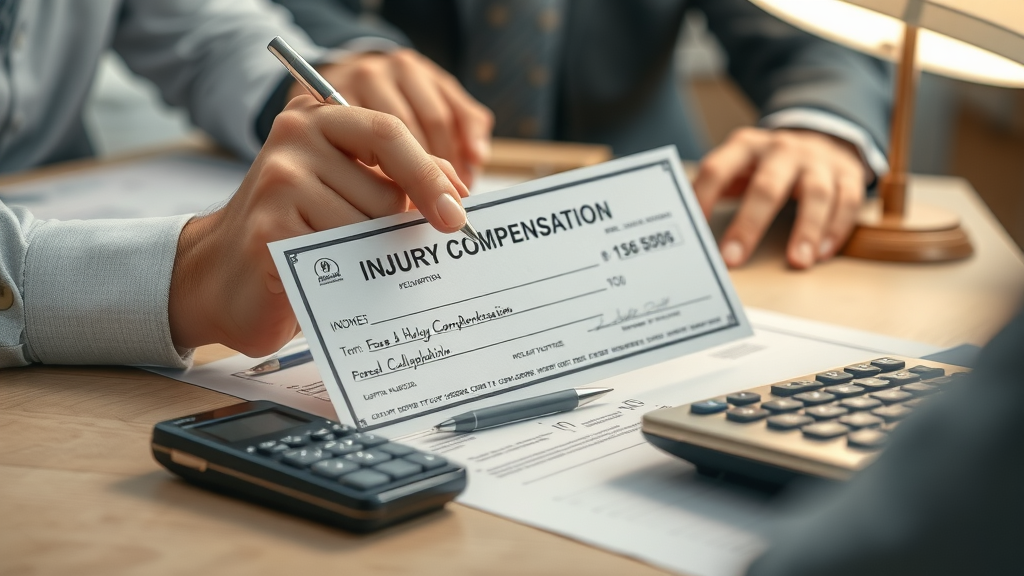Did you know that every year, more than 2.8 million people are hospitalized due to severe injuries in the United States alone? For victims and families, a severe injury isn’t just a medical event—it’s a life-altering crisis that triggers intense legal, financial, and emotional challenges. In this guide, you’ll discover how a personal injury lawyer navigates injury law to win severe injury claims , ensuring victims get the compensation and justice they deserve.
Startling Statistics: The Reality Behind Severe Injury Claims
- More than 2.8 million hospitalizations are caused by severe injuries annually in the US.
- Medical costs for traumatic injuries in personal injury cases exceed $450 billion each year.
- Approximately 21% of severe injury claims result from car accidents and slip and fall incidents.
- Victims of severe injury cases are 30% more likely to require long-term care compared to minor injuries.
- A successful injury claim handled by an experienced injury lawyer results in 3x higher settlements, on average.

"Every year, over 2.8 million people are hospitalized for severe injuries in the United States alone." – National Safety Council
Essential Insights: What You Will Learn About Severe Injury Claims
- The most common types of severe injuries seen in personal injury cases
- How to recognize qualifying cases for severe injury claims
- The step-by-step injury claim process
- The crucial role of a personal injury lawyer or injury attorney
- Strategies for maximizing compensation and overcoming legal hurdles
- Proven actions that set winning severe injury cases apart
Defining Severe Injury Claims: What Qualifies and Why They Matter
What Would be Considered a Severe Injury?
A severe injury is not simply a cut or bruise; it is a life-altering trauma with profound physical, emotional, and financial consequences. Examples include traumatic brain injuries, spinal cord damage, amputations, severe burns, and multiple fractures. In injury law , these injuries significantly affect the victim’s ability to pursue daily activities, maintain employment, or enjoy former quality of life. Because the stakes are so high, severe injury cases usually receive special attention in personal injury law and are entitled to higher compensation.
The impact of such injuries goes beyond medical bills; mental anguish, lost wages, loss of consortium, and long-term care also become central issues in an injury lawsuit . This is precisely why insurance companies and defense teams fight so hard to limit payouts, emphasizing the need for an adept personal injury lawyer who can highlight the extensive damages in front of a jury or during settlement talks.

What is the Criteria for a Severe Injury?
To qualify as a severe injury , the law often considers permanency and significant impact . Injuries that cause long-term disability, major disfigurement, or require extensive medical treatment are typically categorized as severe. Criteria include: prolonged hospital stays, need for surgery, permanent loss of function, or medical documentation from specialists. Additionally, the inability to return to your previous occupation or lifestyle due to the injury adds weight to your personal injury claims .
The legal system expects clear evidence, such as imaging, physician notes, and rehabilitation records, to satisfy these criteria. In states following no-fault injury law , thresholds for severity help determine when lawsuits may proceed outside of basic insurance coverages. For every injury case , properly documenting the full extent and effects of an injury is critical for a fair evaluation and ultimately, for success in court or negotiations.
Common Types of Severe Injury Cases in Personal Injury Law
Personal Injury Cases: Identifying the Most Severe
- Traumatic brain injury (TBI)
- Spinal cord injury (SCI)
- Amputation (loss of limb)
- Multiple fractures and complex bone injuries
- Serious burn injuries
- Internal organ damage
- Paralysis or significant loss of mobility
- Wrongful death cases (representing a deceased person's estate)
In personal injury law , these severe injuries present some of the most challenging and high-stakes legal scenarios. Because the consequences last a lifetime, compensation packages may cover not just immediate medical treatment, but ongoing care, future lost income, and significant pain and suffering damages.

Severe Injuries Resulting from Car Accidents and Slip and Fall Incidents
Many severe injury cases stem from everyday events like car accidents and slip and fall incidents. Rear-end collisions, intersection crashes, and pedestrian impacts frequently result in brain and spinal cord injuries. Similarly, unsafe property conditions—such as icy steps or broken flooring—can cause devastating injuries in slip and fall lawsuits. In such incidents, the liable party’s negligence becomes a focal point, and skilled personal injury attorneys work to demonstrate exactly how their client’s life was upended.
These types of injury claims often require extensive investigation into the scene, eyewitness accounts, surveillance footage, and safety protocols. An experienced injury lawyer will meticulously collect and preserve evidence to build a compelling narrative for insurance adjusters or the courtroom, ensuring all responsible parties are held accountable for severe medical and financial loss.
Understanding Injury Claim Process: Key Steps in a Severe Injury Lawsuit
- Seek Medical Treatment Immediately. Always start by addressing your health and safety. Failure to get prompt care can harm both your recovery and your legal standing in a future personal injury claim .
- Hire a Personal Injury Lawyer. Secure an experienced injury attorney who specializes in severe injuries. Their role is crucial in handling insurance companies, collecting evidence, and protecting your rights.
- Investigate and Gather Evidence. Your lawyer will collect medical records, witness statements, accident reports, photographs, and expert opinions.
- File the Personal Injury Claim. The attorney prepares and submits documents to initiate the claim against the responsible party or their insurance provider.
- Negotiate with Insurance Companies. Most injury cases are settled out of court. Your lawyer negotiates for fair compensation based on all evidence.
- File a Lawsuit if Needed. If negotiations fail, the claim escalates into a formal lawsuit. Discovery, depositions, and hearings follow.
- Trial and Judgment. If no settlement occurs, your attorney presents the case before a judge or jury to pursue the compensation you need and deserve.
- Settlement or Verdict Payment. Once a resolution is reached, payment is processed for medical bills, lost wages, emotional distress, and other covered damages.
What Determines How Severe an Injury Will Be?
Several factors influence whether an injury is classified as “severe” for legal and insurance purposes. The most critical include the nature and location of the trauma, the prognosis for recovery, the age and health of the injured party, and the necessity for ongoing treatment. For example, injuries to the brain and spinal cord generally result in higher impairment ratings than broken bones. Medical assessments play a pivotal role in this determination, as do official documentation, imaging, and surgical reports.
Your personal injury lawyer or injury attorney will often bring in medical experts to offer objective opinions on the expected long-term effects of your injuries. This approach is essential for justifying the extensive compensation often required, particularly when the victim faces permanent work limitations, long-term pain, or reduced life expectancy as a result.

The Role of a Personal Injury Lawyer in Severe Injury Claims
How a Personal Injury Lawyer Builds a Severe Injury Case
- Meticulously gathering and preserving physical evidence and accident records
- Consulting leading medical experts to assess the extent of damage
- Documenting the daily and long-term impact of injuries on the client’s life
- Calculating full economic damages, including medical bills , lost wages , and future care needs
- Preparing compelling arguments for trial or negotiation
The personal injury lawyer acts as a strategist and advocate, proactively identifying every way the injury has changed your life. They use photographs, medical records, psychological evaluations, and statements from family and employers to present a well-rounded, persuasive case. Without this level of detail, severe injury victims risk undervaluation and inadequate settlements.

Strategic Negotiation and Litigation for Personal Injury Lawsuits
A skilled injury attorney excels in both negotiation and litigation. In most personal injury lawsuits , the best results come from aggressive settlement talks, but sometimes a trial is unavoidable. Attorneys use their deep understanding of injury law and knowledge of insurance company tactics to counter lowball offers and demand top-dollar compensation based on the documented severity of injury. Success often depends on presenting indisputable evidence and leveraging expert testimony.
When a settlement cannot be reached, your personal injury lawyer moves the fight to court, using courtroom experience to advocate for your rights before a judge and jury. This two-pronged approach—solid preparation for trial coupled with strong negotiating skill—sets apart winning legal teams and results in better compensation for their clients.
Evidence and Documentation: Maximizing Your Severe Injury Claim
- Complete medical records showing diagnosis, treatments, and prognosis
- Accident reports from law enforcement or property owners
- Testimony from treating doctors and expert witnesses
- Economic calculations for medical expenses , lost wages , and rehabilitation
- Photographs and videos of aftermath and injuries
- Psychological evaluations and documentation of emotional distress
Compelling evidence is the backbone of any successful severe injury claim . Without thorough documentation, insurance adjusters and opposing counsel may question the legitimacy or gravity of your injuries, leading to lower offers or outright denials. That’s why top injury lawyers invest significant resources up front to secure all available evidence before negotiations begin.
Compensation Explained: The Average Cost for a Severe Injury
What Is the Average Cost for a Severe Injury?
The financial impact of severe injuries is staggering. On average, settlements and verdicts reflect not just current medical bills , but anticipated lifetime care costs, long-term therapy, lost wages , and compensation for pain, suffering, and emotional distress. According to national data, severe injury claims often yield settlements from $250,000 into the millions, depending on specifics like injury severity, jurisdiction, and liability.
Plaintiffs with catastrophic injuries and clear liability can qualify for even larger recoveries to cover permanent disabilities, in-home care, adaptive equipment, and loss of future earning capacity. This is why building a robust personal injury lawsuit with the help of a seasoned injury lawyer is crucial to maximize compensation.
| Type of Severe Injury | Average Settlement Amount |
|---|---|
| Traumatic Brain Injury (TBI) | $500,000 - $2,000,000+ |
| Spinal Cord Injury | $350,000 - $1,500,000+ |
| Amputation | $300,000 - $1,200,000+ |
| Severe Burns | $250,000 - $1,000,000+ |
| Multiple Fractures, Internal Injuries | $150,000 - $600,000+ |
| Wrongful Death | $500,000 - $3,000,000+ |

Time Limits and Legal Hurdles in Severe Injury Cases
- Statute of limitations: typically 1–3 years from the date of injury (varies by state, with strict deadlines)
- Insurance reporting deadlines: sometimes as short as a few days to notify involved parties
- Failure to file within time limits can result in the claim being permanently barred
- Procedural hurdles: incomplete accident reports, missing witnesses, or inadequate documentation can undermine your claim
- Special rules for governmental claims or medical malpractice may shorten timelines
Legal deadlines in personal injury cases are unforgiving. Missing a filing date—either with your insurance or in court—could mean losing out on vital compensation. An experienced personal injury lawyer will ensure all documents are filed promptly and prevent costly mistakes that the insurance companies might use to challenge your right to recovery.

Free Consultation: The First Step Toward Winning Your Severe Injury Lawsuit
If you or your loved one has suffered a severe injury, your best move is to schedule a free consultation with a qualified personal injury lawyer . During this critical first step, the attorney will review your case, answer legal questions, discuss potential compensation, and advise you on your next moves—at no financial risk. Quality legal teams work on a contingency fee, meaning you pay nothing unless they win your injury case .
Don’t risk managing a complex injury claim on your own; consult a professional whose expertise can greatly increase your odds of a successful resolution. The sooner you act, the better your lawyer can gather evidence, meet deadlines, and position your personal injury lawsuit for victory.
FAQs: Navigating Severe Injury Claims
-
Do I need a personal injury lawyer for a severe injury claim?
Yes. Severe injury claims are complex, high-stakes cases where insurance companies fight hard to minimize payouts. A personal injury lawyer brings expertise in injury law, evidence gathering, negotiation, and courtroom tactics—all necessary to maximize compensation and protect your rights.
-
How long do severe injury cases usually take to resolve?
Severe injury lawsuits typically take 6 months to several years to resolve, depending on the complexity of the case, the extent of injuries, and whether the case settles early or goes to trial. Timelines also depend on state laws and insurance company practices.
-
Can I claim for psychological impacts from a severe injury?
Yes, compensation can (and often should) include psychological impacts such as emotional distress, anxiety, depression, PTSD, and loss of enjoyment of life. Proper documentation and testimony from medical or mental health experts strengthen these claims.
-
What if the severe injury was partially my fault?
Many states follow “comparative fault” or “contributory negligence” rules. This means you may still recover damages, but your compensation could be reduced by your percentage of fault. A skilled personal injury attorney can help minimize your share of liability.
Key Strategies for Success: What Sets Winning Severe Injury Cases Apart
- Early and thorough evidence collection, including medical records and accident reports
- Retaining credible medical experts to document physical and psychological injuries
- Building a detailed narrative that fully conveys the impact on daily life and future ability to work
- Effective negotiation leveraging all evidence to demand appropriate compensation
- Litigation readiness—preparing for trial from day one to force fair settlements
- Exceptional client-lawyer communication throughout the claim process

Summary of Severe Injury Claims: Critical Takeaways for Injury Victims
- Act quickly: Secure a personal injury attorney and begin evidence collection as soon as possible
- Don’t settle too soon: Wait for full assessment of long-term medical needs before accepting offers
- Document everything: Keep detailed records of treatment, expenses, and emotional impact
- Meet all legal deadlines: Statutes of limitations and insurance reporting rules are strict
- Rely on professionals: Skilled injury lawyers make a measurable difference in compensation and outcome
Talk to a Personal Injury Lawyer: Take Action Now for Your Severe Injury Claim
Don’t wait for insurance companies to dictate your future after a life-changing injury. Contact an experienced personal injury lawyer now to begin your journey toward justice and full compensation. Your recovery—and your rights—deserve the strongest possible advocate.
When pursuing compensation for severe injury claims, it’s crucial to be aware of common pitfalls that can undermine your case. The article “9 Mistakes To Avoid When Filing A Severe Injury Claim” outlines critical errors such as neglecting follow-up medical care, settling too quickly, and providing incomplete information, all of which can significantly impact the outcome of your claim. ( personalinjury-az.com ) Additionally, the piece “Maximizing Compensation for Serious Injury Cases | Key Strategies” emphasizes the importance of prompt medical treatment and accurate record-keeping to strengthen your case and ensure fair compensation. ( vikinglawaz.com ) By understanding and avoiding these mistakes, you can enhance your chances of a successful claim.
 Add Row
Add Row  Add
Add 




Write A Comment